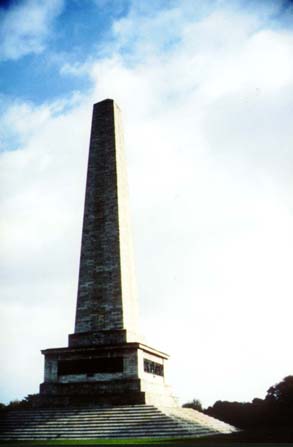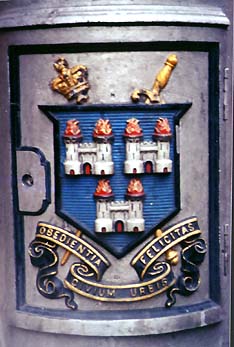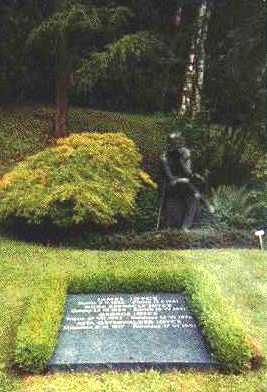|
|
Photo
Album to
Marylin Bender's
|
|

|
Zurich residence,
one of many, of Joyce's, on Universitatstrasse. Joyce lived on the third floor. Photo by Jan Hoeper |
|
|
|
A wall of the Magazine Fort in Phoenix Park, built c. 1734 to defend the Irish during the period of English rule. It had been used as a military museum for many years but is in a state of disrepair and presently under reconstruction. Upon its completion Jonathan Swift wrote: Behold the proof of
Irish sense, from Finnegans Wake,
45.1-6: |
|
|
|
The Wellington Monument
in Phoenix Park, Dublin, a granite obelisk
designed by Sir Robert Smirke and erected in 1817, 205 feet tall and said to
be the highest at the time. Named for the Dublin-born Duke of
Wellington who defeated Napoleon at the Battle of Waterloo, around the base
are scenes in bas-relief from the various battles of the Duke. The
Willingdone Museyroom in the Wake (8.10) is a conflation of the
monument and the museum in the Magazine Fort, also in Phoenix Park (see
above). In this section, 8.1 -- 10.23, Joyce derides Wellington as a
British turncoat. The monument is also referred to throught the Wake,
often as a phallic symbol. Photo and information by Faith Steinberg. |
|
|
|
Shield from Dublin City coat of arms can be seen on lampposts and handsome litter cans around Dublin. It bears the motto, Obedientia Civium Urbis Felicitas, Obedient citizens make for a happy city, as recorded in Ulster's Office Visitation of Dublin, 1607 (see Fox-Davies, The Book of Public Arms, 1915, III, 5-1). In the words of Joyce from the Wake, "the hersomeness of the burger felicitates the whole of the polis," (23.14-15), "obedience of the citizens elp the ealth of the ole," (76.9), "obedient of civility in urbanious at felicity, " (277.8), "Obeyance from the townsmen spills felixity by the toun," (540.25-26), and passim. Likewise the three castles are from the coat of arms of Dublin: "three shuttoned castles (22.34), "of three castles" (101.23, and passim. Photo and information by Faith Steinberg. |
|
|
|
Joyce's grave in Zurich. Joyce died of a perforated ulcer in Zurich on January 13th, 1941. He is buried in Fluntern Cemetery; and the sculpture is by Milton Hebald. It is close by the zoo. "He was awfully fond of the lions," Nora once remarked, "I like to think of him lying there and listening to them roar." Photo by Jan Hoeper, information by Ciceil Gross. |
|



